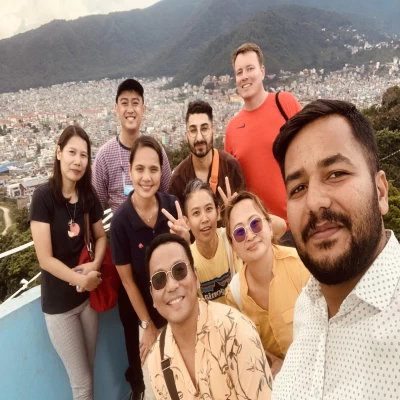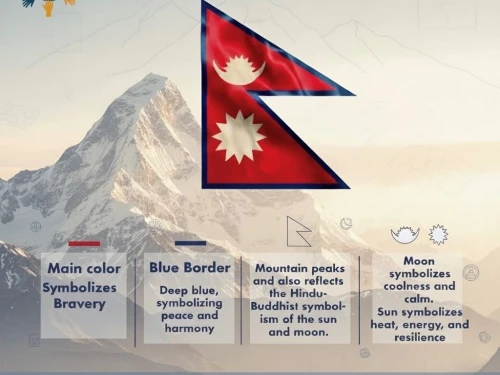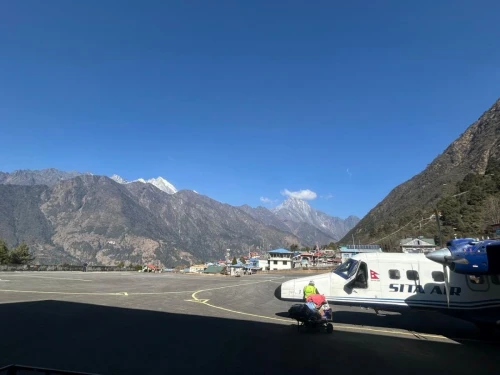The world's highest peak Mount Everest is located at 8848 meters. Everest Valley is bordering Nepal and Tibet. there might be hardly anyone who hasn’t heard about this magnificent peak known as “Rainbow Valley Everest”. well, it’s the dark side of Mount Everest, which is also called a Graveyard valley. only the most courageous hikers, climbers, and adventurous people dare to explore this area.
The gear and equipment, which includes blue, red, orange, and green jackets, tents, and oxygen tanks, among other colors and materials, also contribute to the remarkable and varied array of colors that can be seen in the valley. from a distance, this region seems a mixture of colorful materials that look like a rainbow, so it is named the popular rainbow Valley of Mt. Everest.
Rainbow Valley Mount Everest is a chilling and sobering landmark, named for the bright, colorful clothing of climbers who have perished on their quest to summit the world's highest peak. The Rainbow Valley is a region below the northern ridge of Mount Everest. This area lies just below the summit in the "Death Zone," a region above 8,000 meters where the oxygen air is dangerously thin, weather conditions are serious, and the terrain is perfidious. Because of the narrow trails, climbers who perished in this area typically relocated where they fell or down into the Rainbow Valley.
Every year, many climbers attempt to reach the peak of Mt. Everest. Some successfully reach the summit, while others give up and descend back to lower altitudes. Unfortunately, some lose their lives during the ascent and descent. The area known as the Rainbow Valley on Mt. Everest has been the site of many climbing-related fatalities.
Over the decade, more than 300 hikers have lost their lives on Everest Rainbow Valley, many of them haunting open-air graveyards. This region is infamous for its high fatality rate due to the extreme conditions. The narrow path in Everest's Rainbow Valley trails allows only one person at a time to pass, so the bodies of those who expire are often pushed to Rainbow Valley below.
Climbers must struggle to avoid sickness and freezing to death in the cold because the effects of altitude sickness are so severe in the Death Zone. As a result, Rainbow Valley ends up serving as a grave for those who were forced. Transporting dead bodies is very dangerous No one is willing to take risks for those who are already dead. In addition, it takes many persons to bring a single body. Therefore, there are more deaths, so this place is called Graveyard Valley.

Where is the Death Zone on Everest?
The death zone on Everest is typically situated at a higher elevation above 8000 m. All deaths on Everest, over 300 have died at this point. The Rainbow Valley in Everest is below the northern ridge of the mountain which is also known as the Everest graveyard. This is the area where the oxygen level is insufficient to survive human life in this period, making it dangerous for climbers. In the region, the body cannot acclimatize, leading to a higher risk of altitude sickness and other many problems.
A supplementary oxygen tank must be carried by hikers as they climb the ascending the peak. At such altitudes, altitude sickness and death due to the oxygen tanks.

What happens to the dead bodies on the Everest Rainbow Valley?
The Everest Rainbow Valley is a very dangerous challenging route in the world. The Rainbow Valley dead bodies either remain forever in the death zone Rainbow Valley or may sometimes recovered but, sometimes impossible to recover the body from a higher altitude. Extreme weather, high elevation, and narrow paths make it difficult to carry down the body. Helicopter rescue is sometimes impossible due to the powerful wind.
The cost of recovering the dead body is more than 70 thousand USD. Several bodies have been recovered by paying the higher amount. But the recovery is not easy, no one is not ready to bring down the body. so that, the cost is not limited.
What is the main reason for death in the death zone on Everest?
Death Zone Everest is located at an altitude of 8000 meters. At this altitude the oxygen level is low, the weather is harsh, the wind is strong, and the route is very small. This problem can lead to death. Every step is considered the death point of life.
According to the 2019 Himalayan statistics, nearly 5,000 climbers have climbed Mount Everest, of which 295 have died since 1924. In 1980 the death rate was 1 percent. According to a BBC report, the number of deaths from avalanches has risen to 22.2 percent. Moreover, falls and exhaustion are other causes of death in this area. Between 1970-1980 the mortality rate was the highest at 2.2%. And reduce to 2019, the death ratio was 1%.

Trekking in the Everest Region
Trekking in the Mount Everest Region is a picturesque adventure. It provides wonderful views of the world’s highest peaks. This area has different trekking trails, such as the glamorous Everest base camp trek, the challenging three passes trek, and the Gokyo lakes trek, each offering a unique natural beauty and cultural experience.
Everest Base Camp Trek
The Everest Base Camp Trek on the south side, at a 5364 m height, is one of the most popular trekking routes in the mountain’s region. 40,000 passengers travel through Lukla airport yearly. Trekkers usually fly to Lukla from Kathmandu. From Lukla, trekkers climb the Sherpa Valley to Namche Bazaar, and following the valley of the Dudhkoshi River, you explore Dingboche, Tengboche Monastery, high treks through Mongla and Fortse. Another important place is the Everest base camp via Goresep, Kala Patthar, and Pumori. Finally, you will descend at Lukla and return to Kathmandu after complete14-day itinerary, and your trip ends.

Everest Base Camp Trek With Helicopter Return
The Everest base camp trek with helicopter return is a unique and amazing way to explore the beauty of the mountain region. this trek is suitable for the busy person and old person who is enthusiastic about traveling for a short time on the Everest base camp. Everest base camp trek with helicopter return afterward straight from the Kala Patthar viewpoint. You have to trek only 65 km out of 130. You will explore many places like Lukla, phakding, Namche Bazar, Tengboche, Dingboche, and Lobuche. You will visit all areas you descend the Gorekshep and return with a helicopter that offers a romantic view in clear weather.

Gokyo Lake Trek
This is the most adventurous trek in the Everest region of the mountains, the trekkers following the high route pass of Cho La Pass (53330m). Trekkers' journey starts from Kathmandu to Lukla. You will explore the Namche Bazar, dole, Machhermo, and Gokyo Valley. This trek ascent follows the Dudh Kosi and Khumbu valleys from the homeland of the Sherpa people to the Gokyo valley, which offers panoramic 8000 m peaks, Everest, Cho Oyu, Makalu, and the largest glacier in Nepal. final destination machhermo and descend through Lukla and fly back to Kathmandu.

Sleeping Beauty of Mount Everest Story
The sleeping beauty of Mount Everest Francys Arsentiev is an American adventurer whose biggest dream is to step up towards the highest peak in the world. She is the first American woman to climb Mount Everest without the need for additional oxygen. On May 22, 1998, she and her spouse embarked on their Everest exploration. She ascended to the peak much like Hannah did, but she passed out on the way back. For 3 days, she remained in the same location with no help.
The rescue team found that 3 days later, she was dead from frostbite. They made an effort to body down, but after many attempts, they gave up and left her behind. A climber called her “sleeping beauty” because of the way she was positioned, which is the impression that she was sleeping. Lan Woodall discovered her body on May 23, 2007, and moved her body to a lower position. She spent 9 years in Rainbow Valley before meeting Lan, from 1998 to 2007.

In conclusion,Rainbow Valley and Death Zone a perfidious section near Mount Everest, is called for the colorful clothing and gear of climbers who have expired in the region. It is also famous for its sleeping beauty Everest, and the green boots of Everest. This location serves as a reminder of the mountain dangers and rigid realities of high altitude. The Rainbow Valley including cold, high winds, and the risk of avalanches, make rescue recovery very challenging. Overall, Rainbow Valley Climb needs careful preparation mentally and physically understanding. weather and safety must always remain a climber's top priority.
Mount Glory Treks has 10+ years of experience, organized tours, and travel experiences like trekking, mountain flight, peak climbing, Expedition, Sightseeing tours, jungle safari, city tours, and many other adventures. The main objective of this company is to provide high-quality travel satisfaction and good services. We make you proud by choosing Mount Glory. If you want to go helicopter tours, Heli-treks, and much more, Mount Glory gives you an experienced guide with budget-friendly facilities.




 4 reviews
4 reviews.webp)
.webp)









